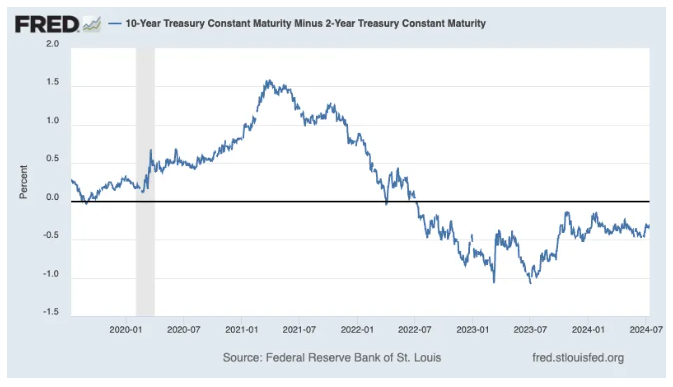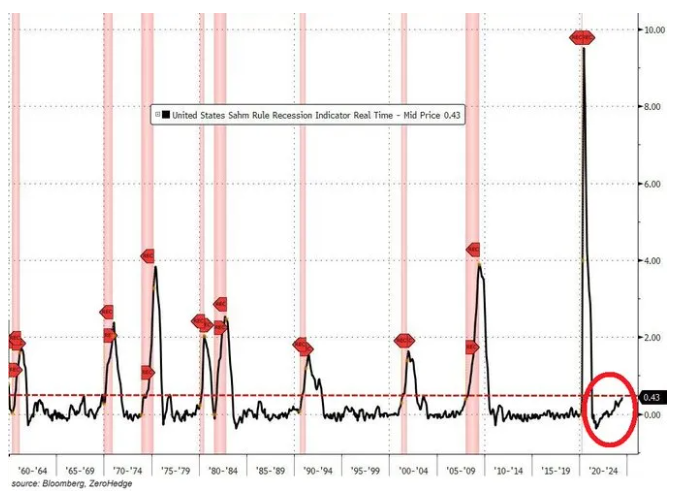Still no recession
2024-07-23
BY CHELTON WEALTH

Still no recession
Economists struggle to predict a recession, even though the same economists say plenty of indicators point to a recession. There is much to be said for many than those previously supposedly reliable indicators. These indicators work even in a soft landing, which is still the baseline scenario. A recession is part of a normal economic cycle, so the question should first be asked where we are in that economic cycle. Since the Great Financial Crisis, many measures have been taken that frustrate the cycle. Part of a typical recession is that excessive investment was made before that recession. The function of such a recession is then to eliminate the excesses. Considering the shortages of millions of houses and other infrastructure, there has been inadequate investment for years. So when a recession comes, it will not be so profound.

The yield curve
A well-known recession indicator is the inverted or inverse yield curve. This has been inverted for more than two years now, but in the absence of a recession, the strong track record of this indicator seems to be broken. The curve is usually inverted because capital markets believe that central banks have raised policy rates sufficiently to contain inflation. In that respect, this indicator has got it right. Inflation has almost normalised, just without a recession. Compared to the past, other things at play affect the yield curve. For instance, central banks are also very active at the long end of the curve through the buyback policy (they are the biggest buyers). Pension funds are also much more active in the long term in the context of ALM studies, a recently amplified phenomenon with leveraged LDI solutions. Only that, since the problems under Lizz Truss have become a thing of the past. Buying long-term government bonds with borrowed money at the trough of interest rates requires a train of thought that cannot be explained even quantitatively.

Money supply developments
Regarding the development of inflation and the likelihood of recession, the Bundesbank used to look mainly at the growth of the money supply, in the Bundesbank’s case, the M3. The idea is that if the money supply shrinks, this must inevitably lead to a recession. The money supply rose unprecedentedly during Corona, but money growth was strongly negative at the end of 2022. A year and a half later, money growth is positive again, with no recession seen in the meantime.

Purchasing managers
The ISM index has a strong track record over several cycles in predicting a recession. Only this time, it was negative for 19 out of 20 months and did not produce a recession. Again, part of the cause is the exceptional development of this cycle, which has been somewhat disrupted by the coronavirus crisis and especially its reaction. If there was a recession, it was relatively short-lived in 2022, mainly because of fiscal and monetary stimulus and the years preceding it. Furthermore, post-Corona, there was contraction and even deflation on the manufacturing side of the economy, but certainly not on the services side. The recession has already happened, just not for the overall economy.

The Sahm indicator
Then there is the lesser-known Sahm indicator, named after an economist (Claudia Sahm) who used to work for the Federal Reserve. Every time the three-month moving average of US unemployment rose 0.5 percentage points above the lowest unemployment rate in the previous 12 months, a recession was bound to follow. This makes sense because when staff are laid off, it is unsuitable for overall consumption, and consumption is usually the most important part of the economy. The unemployment rate in the US was 3.4 per cent at the low point last year, and it has now risen to 4.1 per cent. Now, the demand for labour does fall, but it is all right regarding total layoffs. The main reason for the higher unemployment rate is that there is more supply, partly due to immigration. Moreover, an unemployment rate of 4.1 per cent is also very low from a historical perspective. It is not always about the change, but sometimes the level. Exit Sahm.

Wal-mart indicator
When a recession approaches, consumers become price-conscious and are more likely to choose Wal-Mart. Plotting Walmart’s share price development against the development of shares of luxury goods manufacturers would make it possible to predict a recession. The Wal-Mart indicator has also been wrong at times (in 2015 and 2016), but a recession did indeed follow after 2019. Only it was caused by the coronavirus, and the fact that Wal-Mart’s share price can predict the arrival of the Coronavirus is, of course, absurd. As so often, correlation is not causation. Consumers are now more price-conscious, not because of the impending recession but because of the cumulative effect of high inflation.
Soft landing
A recession was also predicted in the mid-1990s, but even then, a soft landing followed. There was a flat yield curve, money growth stalled, and the ISM index was below 50. If you only wait long enough, eventually (more than five years later), a recession will follow. Yet, every economist tries again to predict a recession in the hope of becoming immortal. This time, however, I would rather bet on five more years of expansion. If there were any excesses at all, they will be eliminated by 2022. This means we are effectively still at the beginning of the cycle. Besides, if a recession comes, it will be much less profound than previous major recessions this century. Those were caused by deflation; the central bank had to go much deeper to stabilise the economy. A recession caused by inflation is less deep, provided central banks cut interest rates in time.

